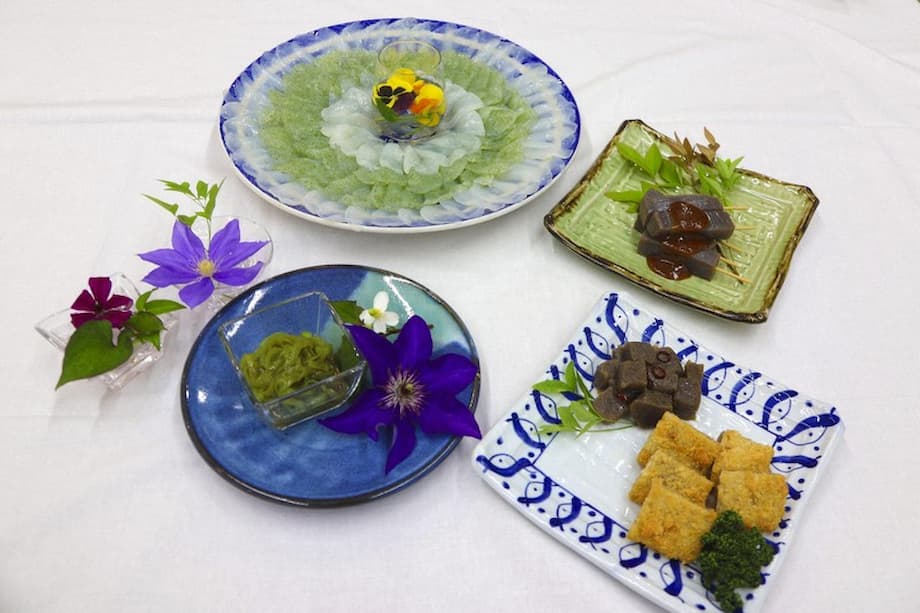A Japanese staple meets Western health goals
Konnyaku, a traditional Japanese food made from the konjac plant, is winning fans far from home. A new online survey by the Japan Konjac Association found strong approval among people who have eaten it in two focus markets. On the United States West Coast, 86.4 percent of respondents who had tried konnyaku said they liked or somewhat liked it. In France, 64.4 percent reported positive impressions. The findings align with a wider push to increase exports as consumers look for foods that are low in calories and high in dietary fiber.
- A Japanese staple meets Western health goals
- What the survey found
- What is konnyaku and how it works in the body
- From traditional blocks to noodles, rice and desserts
- Export momentum and the West Coast gateway
- Marketing and education are changing perceptions
- Nutrition, safety and labeling
- Supply, cultivation and sustainability questions
- How people in the US and France are using it
- What retailers and restaurants can do next
- Key Points
The survey ran from May to August and targeted men and women aged 20 to 69 in California, Oregon and Washington, along with respondents in France. Reasons for liking konnyaku began with low calories, followed by its fiber content. Noodles topped the list of products people said they had tried. Among respondents, 59.2 percent in the US and 27.5 percent in France reported having eaten konnyaku noodles at least once, and satisfaction levels were described as high.
Konnyaku has a neutral taste and a springy texture. It absorbs broths and sauces, which makes it easy to use across cuisines. Many Western shoppers encounter it first as shirataki noodles, a pasta alternative made from the same plant. That is why the noodle format often leads product awareness outside Japan. The association sees the combination of low calories, fiber and culinary flexibility as a natural fit for health minded consumers.
Exporters view the West Coast as a gateway, thanks to large Asian communities and strong demand for wellness focused grocery items. French consumers are showing interest as well, with more products appearing in health food stores, Asian grocers and online channels. The survey measured people who had eaten konnyaku, so building awareness among first time buyers remains a priority for brands hoping to turn curiosity into repeat purchases.
What the survey found
The Japan Konjac Association’s online survey focused on how people who have eaten konnyaku feel about it, which highlights satisfaction among current users more than overall market penetration. Within that group, positive perceptions were widespread, especially on the US West Coast. Respondents frequently cited the appeal of low calories and fiber, benefits that directly match current nutrition goals such as weight management and digestive health. Noodles proved to be the most familiar format, an outcome that tracks with the popularity of shirataki in Western markets where pasta substitutes often serve as an entry point.
Methods and timing matter. The poll ran from May through August and included adults aged 20 to 69 in California, Oregon and Washington, along with respondents in France. Those regions have active Japanese and Asian food communities, which likely helped respondents find and try konnyaku in the first place. The numbers, 59.2 percent in the US and 27.5 percent in France reporting they had eaten konnyaku noodles at least once, reflect that advantage. The taste profile also plays a role in satisfaction. Konnyaku’s mild flavor lets sauces do the heavy lifting, while the texture provides a distinct bite that works in soups, stir fries and salads. Companies eager to grow the category see clear potential if they can turn familiarity with noodles into interest in other formats such as rice style grains, slicing blocks and ready to season items.
What is konnyaku and how it works in the body
Konnyaku is made from the bulb of the konjac plant, Amorphophallus konjac. The plant’s soluble fiber, called glucomannan, forms a gel when processed, creating the familiar firm and elastic texture. Konnyaku is mostly water and very low in calories, commonly around 7 kilocalories per 100 grams. The glucomannan fiber absorbs water and swells in the stomach, which can promote a feeling of fullness. As a soluble fiber, it can also help support regular bowel movements. Researchers have studied glucomannan for its effects on weight management and cholesterol levels when used as part of a balanced diet, although results vary by individual and product. People new to konnyaku or glucomannan based foods often find it helpful to increase intake gradually and drink sufficient water.
Culinarily, konnyaku is a blank canvas. The gel sets into shapes that can be sliced, torn or cut into noodles and grains. The product is almost entirely flavorless, which is an advantage in cooking. It readily takes on the taste of dashi, miso, tomato sauce, curry, soy based marinades or creamy dressings. Preparation is straightforward. Noodles are usually rinsed, drained and warmed in a dry pan to remove excess moisture before saucing. Block styles can be simmered in seasoned broths or stir fried with vegetables and protein.
From traditional blocks to noodles, rice and desserts
In Japan, konnyaku appears in several forms, each with a distinct role in classic dishes. Rectangular blocks, called ita konnyaku, are a staple in simmered dishes. Round balls, or tama konnyaku, are common in skewers and stews. Thin strips, called tsuki konnyaku, and string types, called ito konnyaku, bring texture to hot pots and stir fries. There is also sashimi konnyaku that can be eaten without heating, often served with citrus or miso based condiments. For rice replacement, tsubu konnyaku is shaped into small grains and can be mixed with cooked rice or used in salad bowls. The same base ingredient also goes into desserts where a softer gel is flavored with fruit and sweeteners.
Shirataki noodles and pasta swaps
Many international shoppers discover konnyaku through shirataki noodles, which are typically packed in water and sold in the refrigerated or ambient aisle. They are extremely low in calories and have virtually no digestible carbohydrates. Rinsing and dry pan warming improves the bite and reduces the initial aroma from the packing liquid. Home cooks use them for ramen style soups, quick stir fries with soy sauce and aromatics, and pasta nights with pesto or tomato based sauces. Restaurants pair them with hearty broths to showcase a chewy texture that stands up to long simmering.
Rice style grains and meal kits
Konnyaku grains let diners cut calories and carbohydrates in rice bowls, fried rice and risotto. Some shoppers mix them with regular rice to maintain familiar flavor while lowering energy density in the meal. Exporters have seen strong demand for rice style products in Asian markets outside Japan. Nakaki Food, for example, told regional media that its konnyaku rice sells about six million packets a year in South Korea. The company plans a broader push for a konnyaku based alternative to white rice aimed at people who monitor carbohydrate intake for health reasons.
Export momentum and the West Coast gateway
Japanese producers view the US West Coast as a natural starting point for growth. The region has a deep pool of consumers open to Asian flavors and wellness focused products. Specialty grocers and major chains have expanded shelf space for konjac or shirataki noodles, sometimes placing them near gluten free items or low carbohydrate choices. Online marketplaces list a wide selection of brands and formats, from plain noodles to seasoned meal kits. Product naming can be confusing to newcomers, since labels may say konnyaku, konjac, shirataki or miracle noodles. Clear cooking instructions and recipe suggestions help bridge that gap and reduce the risk that first tries fall flat.
France is a different type of opportunity. Asian grocery stores, health food retailers and e commerce channels are introducing more choices, and chefs are experimenting with konnyaku in tasting menus and bistro specials. The product’s ability to take on sauce makes it a useful vehicle for French classics, from mushroom cream sauces to tomato and herb reductions. As ramen shops and hot pot restaurants spread, diners gain more exposure to textures that are standard in East Asian cuisine. Food tourism and pop culture have raised curiosity about Japanese ingredients, which can translate into at home trial.
Marketing and education are changing perceptions
Domestic enthusiasm in Japan is also part of the export story. In Gunma Prefecture, a theme park devoted to the ingredient hosts a buffet of konnyaku dishes and offers factory tours and hands on workshops. The operator, Yokoo Daily Foods, reported heavy interest and set expansion goals that would allow it to welcome about 1.5 million visitors a year by autumn 2024. That level of engagement builds affection for the product and creates content that companies can share overseas, from recipes to production videos.
Producers are tackling old reputational hurdles as they push into new markets. Some consumers remember konnyaku from decades past as having a strong smell and minimal taste. Processing advances and better recipes have improved the eating experience. Nakaki Food, an exporter of noodles and rice style konnyaku, has emphasized flavor and ease of use in demonstrations and lectures. Company president Toshikazu Nakamura told an audience in 2022 that the image is changing, and he urged younger diners to give it a try.
“The image of konnyaku having a peculiar smell but no taste no longer applies. I want young people to learn about the allure of konnyaku,” said Nakaki Food president Toshikazu Nakamura, speaking at a university lecture, as reported by regional media.
Industry groups also stress health benefits. The Japan Konjac Association highlights low calories and fiber as key advantages, and it frames konnyaku as a supportive choice for people managing weight and blood sugar within a balanced diet. Retailers and restaurants can build on this message by pairing education with tasting, short recipe cards and visible placement in healthy eating sections.
Nutrition, safety and labeling
Konnyaku’s main fiber, glucomannan, has been studied for satiety and cholesterol management when consumed as part of a calorie conscious diet. Outcomes depend on portion size, overall eating patterns and individual factors, so messaging from brands often focuses on the simple facts. Konnyaku is very low in calories, very low in available carbohydrates, and it brings substantial soluble fiber. People who increase soluble fiber quickly can experience digestive discomfort. Starting with small amounts and drinking water with meals makes adjustment easier.
Safety history also deserves attention. Years ago, small gel candies made with konjac created a choking hazard for children and older adults. Food authorities in several countries warned against those mini cup products, and many of the most problematic items were removed from sale. Mainstream konnyaku products today are mostly noodles, blocks and grains meant to be chewed and eaten with a meal. Packaging now often includes chew well guidance and do not give to small children advisories. The ingredient is generally free of common allergens, is naturally gluten free and is typically vegan. Coagulating agents like calcium hydroxide are used during processing, and flavored versions can include soy or added seasonings, so label reading still matters for people with specific dietary needs.
Supply, cultivation and sustainability questions
Konjac farming is labor intensive. Farmers plant corms and nurture them over several seasons, lifting and replanting to reach the size and quality needed for konnyaku production. It usually takes about three years before bulbs are ready for processing. Production is concentrated in Japanese prefectures known for konnyaku expertise, including Gunma. Weather, disease pressure and labor shortages are ongoing concerns for growers, and mechanization is limited.
On the sustainability side, many konnyaku items ship and store at room temperature, which can reduce energy use compared with refrigerated products. Processed noodles and blocks have long shelf lives, which can help control food waste at retail and at home. There is a trade off with packaging. Shelf stable pouches and liquids add volume and plastic. Producers are experimenting with lighter packs, better draining liquids and recycling friendly materials. Some growers are also pursuing organic cultivation under Japan’s JAS program, which requires meeting specific standards and inspections.
How people in the US and France are using it
Practical cooking ideas are driving adoption. On the US West Coast, home cooks often use shirataki noodles for weeknight meals with stir fried vegetables and lean protein, or in broth based soups that keep calories in check. Others mix konnyaku rice with regular rice to lower the calorie count of rice bowls. Fitness communities share tips for classic pasta sauces over konnyaku noodles, with grated cheese and herbs to add richness and aroma. In France, chefs and home cooks have tested konnyaku in bistro preparations, pairing the chewy bite with mushroom based sauces, Provençal vegetable stews and bright vinaigrettes that play well with a neutral base. The key is to let sauces shine and to embrace texture rather than expecting a duplicate of wheat pasta.
Simple techniques make a difference. Rinse noodles under cold water, then dry them in a hot pan until the surface squeaks before adding sauce. Cut long noodles if needed for easier serving. If aroma is a worry, a brief blanch in boiling water helps. For rice style grains, sauté with aromatics to distribute flavor before folding into dishes. People who are new to konnyaku often start by mixing it with familiar ingredients, such as half konnyaku rice and half regular rice, then adjust ratios to taste.
What retailers and restaurants can do next
Awareness remains the biggest barrier to growth. Clear signage that explains what konnyaku is and how to cook it helps first time buyers succeed. Shelf tags can position konnyaku near fiber rich or calorie conscious options. Recipe cards and QR codes that lead to short videos shorten the learning curve. Sampling events with simple sauces or broths let shoppers experience texture and flavor in a low risk setting. For restaurants, menu notes that suggest why a chef chose konnyaku, such as a focus on fiber or a lighter calorie profile, can build curiosity. Training staff to explain quick preparation steps and pairing ideas increases the chance of repeat orders. Brands should avoid overpromising on health outcomes and instead emphasize practical benefits, taste and versatility.
Key Points
- Survey respondents who had eaten konnyaku reported strong approval, 86.4 percent on the US West Coast and 64.4 percent in France.
- Noodles lead product awareness, with 59.2 percent of US respondents and 27.5 percent in France saying they had tried konnyaku noodles at least once.
- Low calories and dietary fiber were the top reasons people said they like konnyaku.
- Konnyaku is made from the konjac plant and contains glucomannan, a soluble fiber studied for satiety and cholesterol support within balanced diets.
- Product formats include blocks, noodles, rice style grains and dessert gels, with shirataki noodles serving as a common entry point for new users.
- Exporters are targeting the US West Coast and France as growth markets, supported by retail placement, online sales and chef collaborations.
- Konnyaku Park in Gunma showcases the ingredient to families and tourists, while companies like Nakaki Food report strong sales of konnyaku rice in South Korea.
- Safety guidance focuses on chewing well and avoiding small gel candies for children, while most mainstream products are noodles and blocks meant for meals.
- Konjac cultivation takes about three years, and producers are exploring packaging improvements and organic options to address sustainability.
- Retailers and restaurants can drive trial with clear cooking instructions, sampling and practical recipes that highlight taste and texture.












